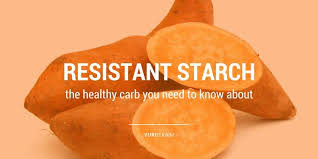by Carra Richling . From: Ornish Living
White flour and related starches have taken a beating over the years. But not all thickening agents are bad for you.
Resistant starch provides “prebiotics,” which are substances that feed the good bacteria.
Even those celebrity nutritionists with a great resistance to carbs are becoming fans of a class of carbohydrates called “resistant starch” (RS). Research is now showing they have a positive impact on our gut microbiome. They improve our feeling of “fullness,” potentially assist in weight loss and insulin sensitivity—and decrease diabetes and cardiovascular risks.
Resistant Starch and Your Microbiome
Potato starch is a “resistant starch,” as is maize corn starch. Foods that contain high levels of resistant starch are under-ripe bananas, uncooked oats, white beans, and lentils. What they “resist” is digestion by the small intestine. Instead, they move directly to the large intestine, where they digest slowly via a fermentation process that feeds some of our best bacteria. Resistant starch provides “prebiotics,” which are substances that feed the good bacteria by releasing short chain fatty acids (SFCA’s) as they ferment. These SFCA’s are food for the colonic microbiome, and when that microbiome is well-fed, the good bacteria flourish.
Less Inflammation, Healthier Mind
Scientists are finding that a well-balanced microbiome decreases inflammation, which is at the root of most disease. It also improves digestion, allowing optimal absorption of nutrients and resulting in an overall improvement to our health. We are now also learning more about the close connection between our minds and our microbiome. Research is showing that a well-balanced gut environment improves our emotional health.
The Types of Resistant Starch
The key to consuming “resistant starch,” as with so many fibrous foods, is to consume it in its “whole” form as often as possible. Fiber itself is becoming a topic that scientists understand with more nuance than they once did. A few decades ago, fiber was only described in terms of its solubility. There were those fibers that were “soluble” and those that were “insoluble” (soluble fibers turn into a gel in water, like oats, or psyllium, do as opposed to insoluble fibers like the cellulose of celery or wheat’s bran, that don’t). Now, we understand that other descriptors, such as “viscosity,” may have a greater match with the fiber’s actual actions and influence within the digestive system.
That said, the four categories of resistant starch are:
- “Type 1,” which digestive enzymes don’t break down (This starch is physically inaccessible, bound within the fibrous cell walls of plants, and is found in whole grains, seeds and legumes. The best way to eat those starches is whole. Think cooked or sprouted garbanzo beans in a salad – which leaves the garbanzo “shell” intact vs, pureed in hummus, which breaks down the bean structure.)
- “Type 2,” containing high levels of amylose found in fruits, potatoes, hi maize corn starch, and other beans.
- “Type 3,” which contain resistant starch when cooked, though they contain more of it when cooled afterward — think potato salad vs. baked potato, also found in rice and oatmeal.
- “Type 4,” processed/modified starch products such as potato starch and again hi-maizeâ corn starch.
Several different types of resistant starch can co-exist in the same food. Depending on how foods are prepared, the amount of resistant starch changes. For example, allowing a banana to ripen (turn yellow) will degrade the resistant starches and turn them into regular starches. Since there are benefits to all, including a variety is key. It’s best to mix the resistant starch foods with other foods. If you’re new to resistant starch foods, you can gradually increase their quantity in your diet to 15 to 20 grams per day.
What Can “Resistant Starch” Do For You?
Specifically, it can:
Improve Insulin Sensitivity
As noted, research has shown that resistant starch improves the gut microbiome, which has been shown to improve insulin sensitivity. A 2017 study published in the journal, Microbiome, found, however, that RS improves insulin sensitivity independently of its effect on the gut microbiota.
Assist With Weight Loss
A study published in October 2015, in Nutrition Journal, demonstrated that adding RS to pancakes resulted in an increase in fat burning and greater satiety (feeling of fullness). These are each significant factors by themselves, but together are helpful aids for weight loss. This is just one of many studies pointing to the weight-loss benefits from RS.
Decreases Risk Of Colon Cancer
Research has shown that resistant starches decrease inflammation in the colon and can reduce the risk and progression of colon cancer. A 2014 study published in Nature Reviews Microbiology attributed the cancer-related benefits to the short-chain fatty acids (SCFA’s) produced in the gut from the consumption of resistant starch.
Here are a few simple ways to include resistant starch in your diet:
Make A Healthy Cooking Swap
Use unmodified potato starch (not flour, and choose the non-GMO kind) to thicken sauces instead of using a fat like butter. One tablespoon of potato starch adds approximately eight grams of resistant starch. This swap provides a double benefit: fewer calories from unhealthy fat and more rewards for fiber fermentation in the colon.
Eat Your Beans
One cup of beans has on average 7 grams of resistant starch.
Enjoy A Health-Healthy Potato Salad
Potatoes are a good source of resistant starch. The RS level increases if you let the potatoes cool after cooking. So, enjoy a healthy potato salad loaded with RS and feed your gut microbiome. Leave the skins on for extra fiber.
I can’t think of a more satisfying way to start consuming more resistant starch consumption than our delicious cornbread and chili. (See Ornish Lifestyle Medicine Sample Menu 1).
Which delicious, digestion-friendly, high RS bean, whole grain or fruit will you try today?




No comments:
Post a Comment